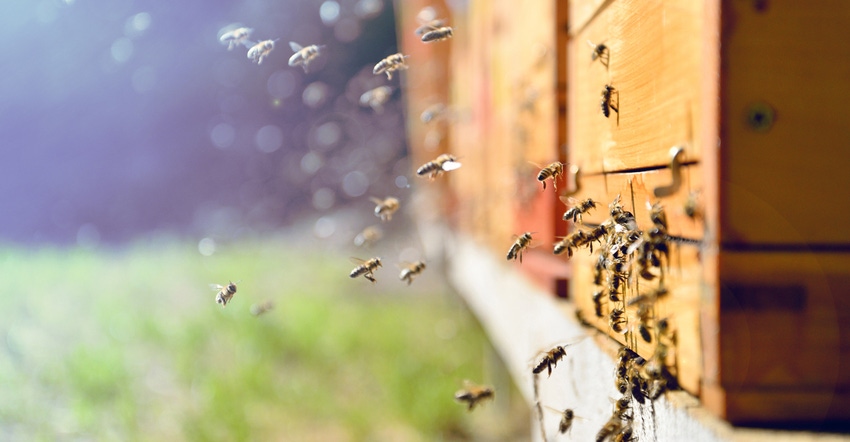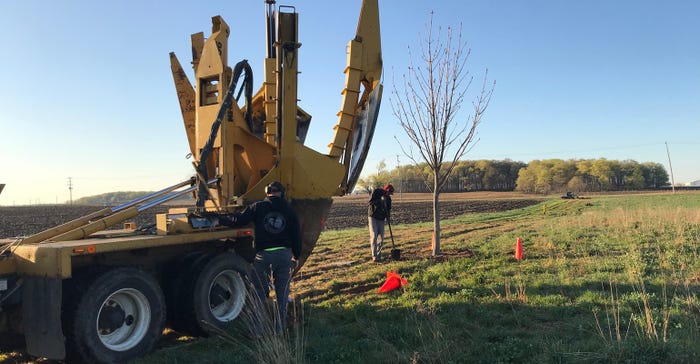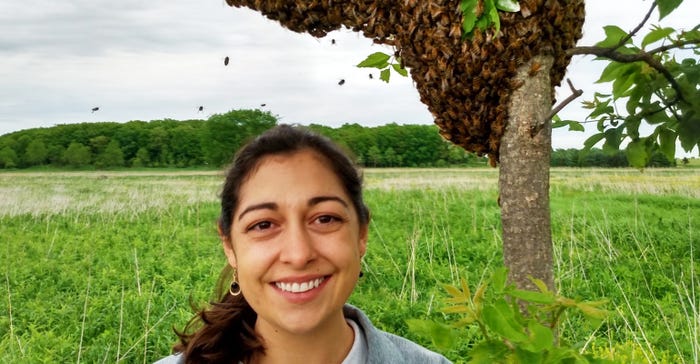June 16, 2021

Michigan State University is stepping up its research in pollinator studies by converting a building formerly used for indoor animal air quality research into the Pollinator Performance Center, located on the south side of campus. It also will be used for teaching, equipment storage and outreach through MSU Extension.
Around the facility are 15 acres that will be used for pollinator-related field experiments. Renovation of the building is underway, but updates to other areas have already been completed. In May, staff from the MSU Infrastructure Planning and Facilities Department planted several hundred trees and wildflowers along the perimeter of the center, which will act as a wind barrier and pollinator food source.
In fall 2020, honeybee colonies were moved to the Pollinator Performance Center from the MSU Extension and education apiary in Lake City. Colonies from the MSU Entomology Farm were added in spring 2021, completing the teaching apiary.
The center will also apply for certification from the Michigan Department of Agriculture and Rural Development (MDARD) as a honey processing facility.
Ana Heck, an MSU Extension apiculture educator, says a completely accessible honeybee yard for learning opportunities is part of the long-term plan as well.
Protecting pollinators through education
Heck, previously with the MSU Department of Entomology, was hired in her Extension role about a year ago to bolster the university’s outreach capacity, in conjunction with the announcement of the center.
She is looking to strengthen partnerships with industry organizations that are crucial to reaching beekeepers across the state, including the Michigan Commercial Beekeepers Association and the Michigan Beekeepers’ Association — which was established in 1865 and is the longest continuously operated agricultural organization in the state.
“There’s no official registry, but we estimate there are roughly 10,000 beekeepers in Michigan,” Heck says. “We have commercial beekeepers, small-farm businesses that use beekeeping to generate income and hobbyists, so it’s a wide range of people we’re serving through our outreach programs.”

PLANTING TREES: The Michigan State University Infrastructure Planning and Facilities Department planted trees in May.
One of these educational endeavors is Heroes to Hives, a program through MSU Extension that gives military veterans access to beekeeping training.
“The center gives us a home base to offer these trainings and ideally do more of them,” says Heck, who helps administer Heroes to Hives. “Dedicated on-campus space is a huge boost to us.”
In addition to educating beekeepers, Heck is responsible for creating protection plans that ensure the short- and long-term health of pollinators.
She is the co-author of the Michigan Managed Pollinator Protection Plan, as well as other resources such as the Blueberry Pollinator Stewardship Guide and the Vegetable Pollinator Stewardship Guide. These documents are aimed at helping the agricultural community that relies on pollinators be a partner in protecting them.
“Growers deal with a variety of pests, and one of the ways they manage them is by spraying pesticides,” Heck says. “I work with growers on ways they can protect their crops from pests while reducing unintentional harm to pollinators.”
Outside of agriculture, Heck says there are steps people who care about pollinators can take.
“I’m frequently asked what members of the community can do to help, and it’s important to know that beekeeping is time-consuming and requires training,” she adds. “We don’t necessarily need more beekeepers, but planting flowers is a great service to pollinators. They need a diverse diet to be at their healthiest, and flowers can be a big part of that, so that’s what I recommend.”
Opportunities for growth
Alongside Heck at the Pollinator Performance Center is Meghan Milbrath, an assistant professor in the Department of Entomology, who leads the Michigan Pollinator Initiative. MPI was created by MSU AgBioResearch and MSU Extension in 2015 to promote pollinator research and education across the state.
“Michigan is one of the most important states for pollinators, in particular honeybees, because of our agricultural industries,” Milbrath says. “But it’s not just for Michigan. Our pollinators are supporting the national food system. We are a top 10 state in honey production, and we’re one of six states where large numbers of colonies are located during the summer for both honey production and crop pollination, but our colonies are also pollinating crops in other states.”
Milbrath pointed to the expanding infrastructure as a key component to applying for and receiving large federal grants. She says it’s something that was near impossible until now.
“One of the limitations we previously had without this space was that we couldn’t run breeding programs or set up research apiaries,” Milbrath says. “We didn’t have the capacity to have that many hives. Now that we can build on this foundation, the possibilities are so much greater.”

APICULTURE EDUCATOR: Ana Heck, an MSU Extension apiculture educator, says a completely accessible honeybee yard for learning opportunities is part of the long-term plan.
A nationally recognized expert on the topic, Milbrath is a sought-after speaker for beekeeping organizations around the country.
Her faculty position is split 50-50 between research and Extension, focusing on disease issues and pesticide risk assessment. Outreach efforts include co-authoring pollinator resources with Heck and delivering training to beekeepers. Milbrath also owns and operates The Sand Hill Apiary in Munith, Mich., a small honeybee and queen-rearing operation.
In her research, she has explored nosema, the most common fungal disease affecting adult honeybees. More recently, Milbrath received Rackham Research Endowment funding to study European foulbrood, a bacterial pathogen about which little is known in Michigan. Milbrath and her team plan to characterize current strains and their distribution, using new and existing data.
“The Pollinator Performance Center is critical in all of this because it allows us to do so much more,” Milbrath says. “The scope of our research, teaching and outreach will now better reflect the importance of pollinators to our state.”
Source: MSUE, which is solely responsible for the information provided and is wholly owned by the source. Informa Business Media and all its subsidiaries are not responsible for any of the content contained in this information asset.
You May Also Like




